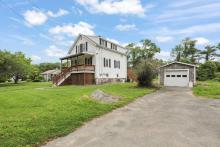Quahog repopulation on the horizon for Dartmouth, Wareham, Fairhaven
Quahoggers take heart. Populations of the sought-after shellfish in Dartmouth, Wareham, and Fairhaven may soon be on the rise.
Thanks to money set aside for the restoration of Buzzards Bay, Dartmouth Harbormaster Steve Melo participated in building new “upwellers” – essentially floating nurseries for quahogs – for each of the towns alongside Wareham and Fairhaven waterways officials.
“Hopefully, this will add to the resurgence of the quahog industry or culture in Dartmouth,” said Melo. He said that each of the three upwellers — one for each town — can host about one million seeds.
A settlement associated with the Bouchard oil spill funded the project. The spill dumped 98,000 gallons along nearly 100 miles of Buzzards Bay coastline in 2003, affecting wildlife, shellfish beds, and recreational activities. In 2011, state agencies secured a $6 million settlement to restore wildlife and habitat.
For this project, each town received $10,000 to build the upwellers. Slightly more than $12,000 will be awarded to the three towns to divvy up for the purchase of seed quahogs over the next two years, said Wareham Harbormaster Garry Buckminster.
The upwellers look like ordinary, wooden floating docks, but beneath are trap doors that open onto troughs where minuscule quahogs will be placed. In those troughs, nutrient rich water will be pumped through the system by an electrical engine, helping the shellfish grow.
The floating docks were built at the Wareham Harbormaster’s workshop this winter, and Melo expects that the upwellers, or floating upweller systems as they are officially called, will be in the water by June.
“All three towns came together to build the upwellers. We helped both towns build their upwellers, and they helped us build ours,” said Buckminster.
The goal is to replenish quahog stock across Buzzards Bay for two reasons, said Buckminster. First, the water-filtering shellfish help keep the bay clean. Second, recreational and commercial fisherman suffered financially due to the spill.
The project complements a quahog relay that Melo started last year. Grants supplied Dartmouth with the first run of what will be a total 3,200 bushel of contaminated quahog for the Padanaram Harbor. Over a four-year span, the quahogs will be transplanted from the polluted Taunton River to Dartmouth, where they will self-clean and be ready for harvest.
“The quahog relay were full-grown, mature quahogs that need to purify themselves. [Now,] we’re growing clean quahog locally. These are seeds that will be able to mature in Dartmouth waters,” said Melo.
It takes about three years for quahogs to grow large enough to be harvested. Melo explained that, comparable to agriculture, the seeds will be grown in the upwellers until they’re mature enough to bury themselves in open waters. Then, they’ll be transplanted — similarly to sprouts — in designated fields, where they’ll be allowed to grow, and hopefully reproduce, said Melo.
“If we bring industry back, there has to be a conscious effort to keep it going,” said Melo, expressing concern over the $24,000 shellfishing budget, that he said he more than doubled with grant funding.
Buckminster said there’s no guarantee the quahogs will survive as, just like in growing crops, there is the possibility of failure. However, by looking to area towns that have implemented similar programs, such as Falmouth, he’s confident the project will succeed.














